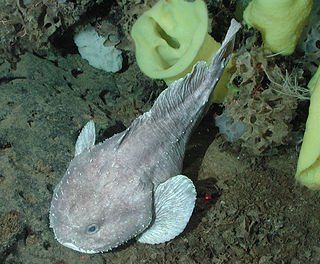
The fish family Psychrolutidae contains over 35 recognized species in 8 genera. This family consists of bottom-dwelling marine sculpins shaped like tadpoles, with large heads and bodies that taper back into small, flat tails. The skin is loosely attached and movable, and the layer underneath it is gelatinous. The eyes are placed high on the head, focused forward closer to the tip of the snout. Members of the family generally have large, leaf-like pectoral fins and lack scales, although some species are covered with soft spines. This is important to the species as the depths in which they live are highly pressurized and they are ambush/opportunistic/foraging predators that do not expend energy unless they are forced to.

The Pacific staghorn sculpin is a species of marine ray-finned fish belonging to the family Cottidae, the typical sculpins. This species is found in the eastern Pacific Ocean. It is the only species in the monospecific genus Lepidocottus.

The fourhorn sculpin is a species of ray-finned fish belonging to the family Cottidae, the typical sculpins. This species has a Holarctic distribution and can be found in marine, brackish and fresh waters.

Myoxocephalus is a genus of marine ray-finned fishes belonging to the family Cottidae, the typical sculpins. They are found in the northern Pacific, Arctic and Atlantic Oceans, with a few species in lakes.

Gizhigin Bay is a wide bay northwest of Kamchatka, Russia. It is the northwestern arm of Shelikhov Bay in the northeast corner of the Sea of Okhotsk. The settlements of Evensk and Gizhiga are located at the head of the bay.

Enophrys is a genus of marine ray-finned fishes belonging to the family Cottidae, the typical sculpins. These fishes are found in the northern and eastern Pacific Ocean.

The belligerent sculpin, or flathead sculpin, is a species of marine ray-finned fish belonging to the family Cottidae, the typical sculpins. This species occurs in the northern Pacific Ocean.

Megalocottus is a small genus of marine ray-finned fishes belonging to the family Cottidae, the typical sculpins. These fishes are found in the western Pacific Ocean.

Microcottus is a small genus of marine ray-finned fishes belonging to the family Cottidae, the typical sculpins. These fishes are found in the northern Pacific Ocean.
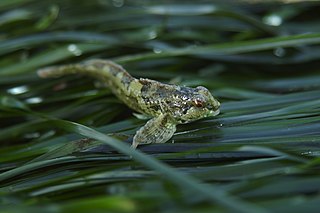
Oligocottus is a genus of marine ray-finned fishes belonging to the family Cottidae, the typical sculpins. These sculpins are found in the northern and eastern Pacific Ocean.
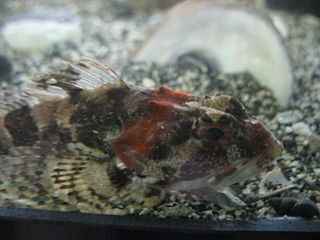
Myoxocephalus aenaeus, commonly known as the grubby, or little sculpin, is a species of marine ray-finned fish belonging to the family Cottidae, the typical sculpins. This species is found in the northwestern Atlantic Ocean.

Myoxocephalus brandtii, the snowy sculpin, is a species of marine ray-finned fish belonging to the family Cottidae, the typical sculpins. This species is found in the northwest Pacific, with a range extending from the Sea of Okhotsk to Hokkaido and the Sea of Japan.

Myoxocephalus jaok, the plain sculpin, is a species of marine ray-finned fish belonging to the family Cottidae, the typical sculpins. This species is found in the northern Pacific Ocean and adjacent Arctic Ocean.

Myoxocephalus niger, the warthead sculpin, is a species of marine ray-finned fish belonging to the family Cottidae, the typical sculpins. This demersal fish is found in the northern Pacific Ocean, with a range extending from the Peter the Great Gulf and the Kamchatka Peninsula into the Bering Sea. It is found at depths from 0 to 50 m.
Myoxocephalus ochotensis is a species of marine ray-finned fish belonging to the family Cottidae, the typical sculpins. It is native to the northwest Pacific in the Sea of Okhotsk. Very little is known about this species.

Myoxocephalus scorpioides, the Arctic sculpin or northern sculpin, is a species of marine ray-finned fish belonging to the family Cottidae, the typical sculpins. This fish is found in the Arctic Ocean.

Steller's sculpin, also known as frog sculpin, is a species of marine ray-finned fish belonging to the family Cottidae, the typical sculpins. This species is found in the northern Pacific, from the Aleutian Islands to the Sea of Okhotsk and the Sea of Japan. Described by Wilhelm Gottlieb Tilesius von Tilenau in 1811, it is the type species of the genus Myoxocephalus.
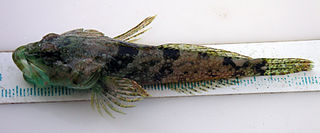
Artedius lateralis, also known as the smoothhead sculpin or round-nosed sculpin, is a species of marine ray-finned fish belonging to the family Cottidae, the typical sculpins. The species, commonly found in the intertidal zone and to depths of 43 feet, is native to the northern Pacific, from Russia and the Bering Sea to Baja California. Growing to a length of 14 centimeters, it takes its name from the lack of scales on its head.

The butterfly sculpin is a species of fish in the family Agonidae. It is found in the North Pacific Ocean.
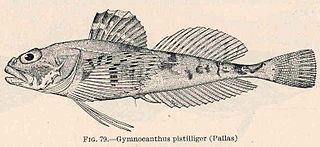
Gymnocanthus pistilliger, the threaded sculpin, is a species of marine ray-finned fish belonging to the family Cottidae, the typical sculpins. This species occurs in the northern Pacific Ocean.


















